Positive Signs the M&E Industry Can Handle, Deliver Equality
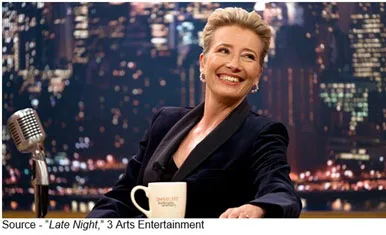
Have you ever wondered how the M&E industry, a business that had such a basic premise (entertain folks, give them a few minutes/hours of escape) has evolved into the point guard for change around the world?
We started thinking about the magnitude of the challenges and opportunities the industry faced as we began looking over the program for IBC next month.
There was a time when content creation was centered in Hollywood and was ruled by the major studios (and their predecessors) – Disney, Warner, Universal, Sony, Paramount, Columbia – and their stuff was distributed to theaters and TV networks around the globe.
Yes, there were big studios in France, India, China and other countries around the globe; but people who wanted to “make it” in the industry always set their sights on Hollywood, regardless of the difficulties and challenges.
Then Netflix, Amazon and the tech-based IP-opportunists saw a new way to entertain and connect with folks on their own terms – anytime, anywhere, any screen – and the Hollywood power players saw shift happen.
New opportunities opened up for the thousands of indie filmmakers around the globe.
While the studios/networks worked aggressively to maintain and regain their entertainment power base, the community also stepped up to address the #metoo movement, which had been around for a long time but rightfully started to gain prominence.
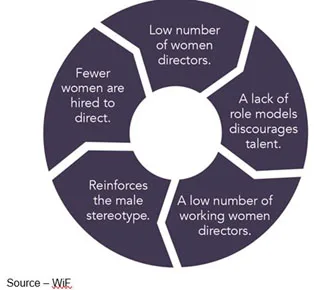
And as we approach IBC, the best thing industry experts, leaders and, well, everyone can say is shift is everywhere!
Yes, Amsterdam is a great city, and in many ways symbolic, especially when it comes to equality and diversity. It’s one of only six countries on the planet that – Belgium, Denmark, France, Latvia, Luxembourg, and Sweden – according to the World Bank that scored 100 on 35 criteria for legal gender equality and parity.
Since the U.S. isn’t included on this vaunted list, at least the content production/distribution industry is taking the issue seriously and helping make change happen.
Kristalina Georgieva, World Bank’s interim president, is happy with the progress. She noted, “2.7 billion women are still legally barred from having the same choice of jobs as men.”
And following the shift in the U.S. Congress, the feminist group Guerrilla Girls observed, “Hollywood is still worse than the U.S. Senate.”
But some honest progress has been made with tentpole and box office hits like – MIB, X-men: Dark Phoenix, Avengers: Endgame, Godzilla: King of the monsters, Captain Marvel, Zombieland: Double Tap, Charlie’s Angels, Terminator 6 and Late Night – at least there is some positive movement.
Still, there are people who track things and give the industry an annual report card on their overall progress.
These include San Diego State’s Center for the Study of Women in Television and Film, Sundance Institute, University of Southern California’s Annenberg Initiative and probably a lot more internationally.
But the good news according to the SDSU study was that the percentage of women directors grew from 29 percent in 2017-18 to 33 percent in 2018-19, while the percentage of women writers rose from 26 percent last year to 32 percent this year.
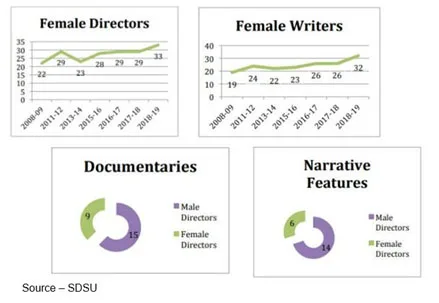
The challenging news that is starting to be addressed is that men still outnumber women two to one in Indie films.
According to a study by The Wrap early this year, 18 percent of the films released by the majors were directed by women. That was up from a token three percent in 2018.
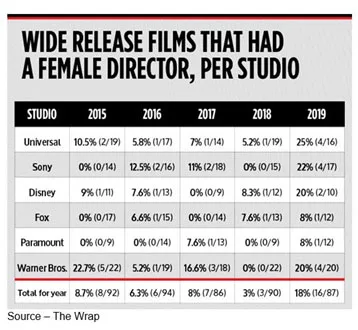
Studies by USC and SDSU found that four of the top 100 highest-grossing films in 2018 were directed by women.
While this year a move to better diversity seems to be happening.
We’d like to believe that WiF’s (Women in Film) Kirsten Schaffer is right when she noted how projects get made.
You know, directors and producers are the first to be hired and it goes down from there for the other members of the production team.
Awhile back Jim Gianopulos, Paramount’s boss, sent out a company-wide memo that the studio was establishing a Content Creation Council focused on making the company’s greenlight and development process more inclusive at all levels of production.
He noted, “Special attention will be paid to our storylines, our talent in front of and behind the camera, our vendors and our shooting locations.”
While the Hollywood six have been busy consolidating, their IP-centric competitors – Netflix, Amazon and others – have been busy improving their gender mix and marketshare.
Last year, Morning Consult reported that since 2013, out of 200 original films 27 percent of the projects were directed by women.
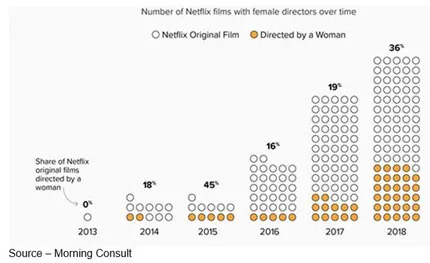
And with more than 150M subscribers in 190-plus countries, the company seems to be doing a pretty good job of picking the right teams and projects that appeal to an eager audience.
Ted Sarandos, chief content officer, and his team seem to be creating a path for female and minority directors and crews by featuring their works.
Amazon Studios is also showing that it’s growing and reaching its audience with projects more than just tentpoles but with low-to-mid budget films from Indie studios.
They spent a whopping $14M for Mindy Kaling’s broad comedy, Late Night, at Sundance that touched just about every issue majors have been shy about addressing until recently.
Think about it:
- 59-year-old British woman, Indian woman in 30s
- Age gap, cultural barriers
- Workplace diversity, sexism, and the inner world of network television
- Woman in male-dominated talk shows
- Token woman of color in all-white writing room
The good news is that it resonated with the audience!
Amidst all of the change that is taking place in the content delivery industry, including appointment and OTT TV, there should be some level of attention paid to what the viewers around the globe will pay for and watch.
If there are positive changes behind and in front of the camera, will the projects attract sufficient viewers? Or given a choice, will viewers turn to/prefer the male-dominated stereotypes?
For an answer, Parrot Analysis reviewed the gender profile of a portion of the 10,000 titles they track across 100+ countries to discover were high-profile titles last year like The Marvelous Mrs. Maisel and Money Heist/La Casa De Papel a trend or fluke?
Perhaps obviously, male-led shows dominated the top 100 shows while gender neutral shows like Crown of Thrones captured an overall greater audience.
While they’ve committed to adding gender quality considerations in all of their analysis in the future, they analyzed results in what we would normally consider one of the more male-dominated audiences, Latin America.
The analysis covered Mexican, Argentinian, Columbian and Brazilian markets in three categories – international titles (Walking Dead, Vikings, superheroes),digital originals (Big Bang Theory, Netflix, Amazon, etc.) and regional/local shows.
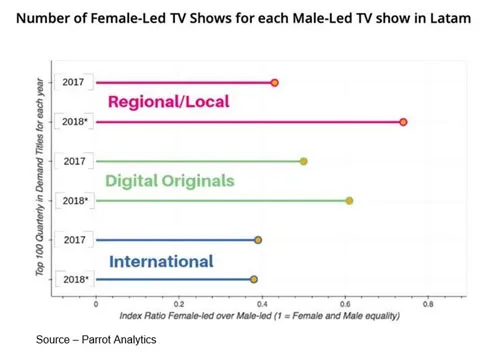
Parrot found that female-led regional and digital originals gained viewing preference over male lead roles.
In fact, in 2018, female shows were three-quarters of the way to full parity with male shows.
That wasn’t true of the international titles but then, there were also far fewer female specific and female-centric projects, so a direct comparison wasn’t possible.
Looking at the Parrot Analysis for national and international OTT content as well as the more in-depth view of Hollywood and Indie project production/distribution, there seem to be a broader range of content offerings with greater diversity.
Despite the dramatic shift in the way content is being offered and consumed, some industry veterans don’t believe the business can pull it off.
Amir Malin, of Qualia Capital and former head of Artisan Entertainment, is one of those nay-sayers.
“The major studios have not been choreographed or run to be entrepreneurial,” he said. “It’s a system that’s been intoxicated with a ‘cover my ass’ mentality. Simply put, it’s a defective system, and when a business paradigm is defective, very good people start doing things that are counterproductive.”
Allan McLennan, Chief Executive of PADEM Media Group, who has been instrumental in helping studios, agencies and exhibitors as well as IP networks and video distribution firms for more than 20 years; has a different and more optimistic view.
“Pessimists spend too much time looking in the rearview mirror,” he commented.
“Yes, a few still count on the blockbusters but most have grasped that the younger audience is becoming more interested in streaming content on her/his iPhone in addition to watching on their TV’s or in theaters,” he continued. “And interestingly, there are a few of the studios looking closely, not just at the profiles of this audience, but also at an emerging generation of content producers.
“There is literally a world of Gen Z and Gen Alpha folks that have grown up watching and creating very professional content for YouTube,” McLennan observed. “They are the ones that are helping to not only contribute but lead the M&E industry’s future.”

He’s not alone in his optimism.
A recent Beano Studios report found that 55 percent of Gen Alphas regularly create video content.
Another reason we’re optimistic that we will see the changes in our lifetime is that the youngsters (born after 2010) belong to what is being called the post-stereotype generation.
They base judgements on individual merit, gender is irrelevant.
With the right assistance, they can move the industry and the world to leave the stereotypes of identity and differences behind us.
Shift happens … just not overnight.
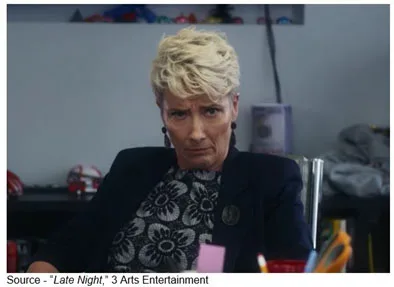 We think the evolution is already taking place, even though Katherine Newbury looked again at the World Bank report and said, “No, I didn’t say it in any of those words.”
We think the evolution is already taking place, even though Katherine Newbury looked again at the World Bank report and said, “No, I didn’t say it in any of those words.”
We’ll see what the IBC and SMPTE sessions do to pave the way.
###